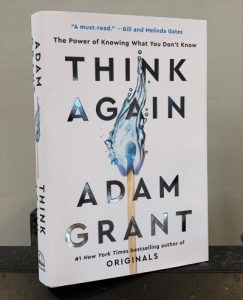 Adam Grant, THINK AGAIN: The Power of Knowing What You Don’t Know (2021)
Adam Grant, THINK AGAIN: The Power of Knowing What You Don’t Know (2021)
This is a recent book, still on the bestseller lists, by an author I had not previously encountered. He’s a professor and TED talker. The book seems a little bit self-helpy, so I came to it guardedly. It seems to me that many self-help books identify a problem they claim you have, and then tell you how to fix it, to their advantage. Like that snake-oil salesman*.
At the same time, this book presents itself as one about “knowing what you don’t know,” which suggests to me the essence of science: being willing to update beliefs with new evidence, of acknowledging that what you think is true may not be true forever, about how to be a life-long learner.
So, given that I already understand how conclusions should be provisional and subject to new evidence, what else can this book tell me? This is what asked myself before I read it. (And the answer is: the distinction of roles in point #1 below. There also several points, below, that confirmed my existing principles and conclusions. Is this therefore an example of motivated reasoning, of simply reading to confirm my existing beliefs? Actually no; I didn’t realize what the book would be about, exactly, before I read it. That it confirmed much of what I’d already concluded suggests to me that there is a reality out there that, no matter from what direction you approach it, converges to the same place.)
I won’t summarize the entire book, though it is effectively written with many anecdotes and personal examples. The most striking one, the first of many, is how among a group of 1949 firefighters in Montana, one survived by, counterintuitively, using matches to burn a patch of grass, which he then lay on as the big fire passed over him. He was mentally fit; he had the ability to rethink and unlearn.
How the popular story about the frog in the pot of water… isn’t true. The frog jumps out as soon as the water gets uncomfortably warm.
Lots of stories like that.
This is a book that, as I didn’t notice before I started it, summarizes itself in the author’s “top thirty practical takeaways” (pp251-257). So I’ll summarize my own take-aways from among those points.
- #1: “Think Like a Scientist.” I’ll quote the summary, adding some bold: “When you start forming an opinion, resist the temptation to preach, prosecute, or politick. Treat your emerging view as a hunch or a hypothesis and test it with data. Like the entrepreneurs who learned to approach their business strategies as experiments, you’ll maintain the agility to pivot.” This is the subject of the book’s chapter 1: respectively, try not to deliver sermons to protect our own ideas; to argue the flaws of others’ reasoning; or simply to seek to win over an audience. This characterization of the roles many people in public life play, as opposed to scientists, is the best take-away I have from this book. (As I’ve noted many times: politicians and lawyers aren’t interested in the “truth”; only in winning.)
- #12: “Ask ‘What evidence would change your mind?’” Mentioned in my Principles, I think: if you have a belief that no imaginable evidence could change, then you are by definition irrational and not worthy of respectful engagement.
- #18: “Complexify contentious topics.” “There are more than two sides to every story.” Again one of my themes: reality is complex; to think an issue is black and white, right or wrong, good or evil, is to be simple-minded – and unrealistic.
- #24: “Abandon Best Practices”. The subject of his Chapter 10, where he uses NASA space shuttle disasters as examples. I’m not sure his critique here quite is on target. In my time in the aerospace industry, we spent years, beginning in the 1990s, continually refining our processes, our practices, and part of that process (or process improvement) was to refine processes through collection and analysis of data, of attending conferences to compare “best practices” from other companies, and so on. But his core point is valid: never think your practices are perfect and not subject to revision.
- #27: “Throw out the ten-year plan.” He says, “What interested you last year might bore you this year—and what confused you yesterday might become exciting tomorrow.” This point struck me particularly since I have always in my personal life tended to over-plan. I decide at the beginning of a year, or a season, what books to read, which projects to work on, over the next three or six months. Inevitably my attention shifts to something different, different books or projects, and I realize the time spent planning was a waste. I’ve tried to overcome this habit by accepting chance, coincidence, and synchronicity. So, for example, I now never decide which book to read next, until it’s time to pick up a new book. Sometimes it’s from a planned list of books to read (which I still maintain), and just as often, something out of the blue. So I’ve learned this point! Though it took me years.
So, this is a book that seems self-helpy, but is as much one of the many books of the past couple decades that applies discoveries in psychology, of how the mind works, about discoveries of psychological biases and perceptual illusions. All of these are, in a crucial sense, the development of the idea to know thyself.
—
* And religions: did you not know that you’re a sinner??, said the missionaries to the Native Americans. We can fix you!





